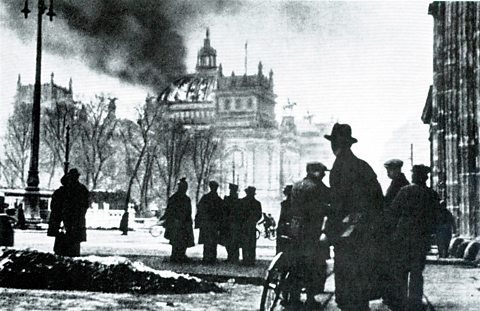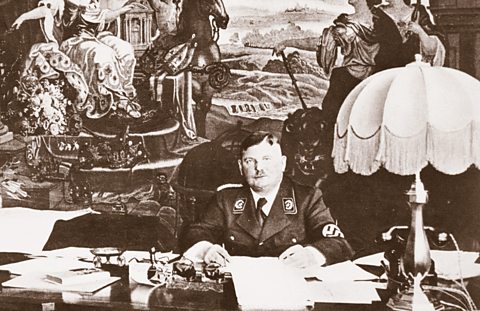Methods of increasing control
By 1933 Hitler was a step closer to his goal of having complete control of Germany. Before the March elections of that year he had been made Chancellor under President Paul von Hindenburg. This gave him the second most powerful political position in Germany.
After becoming Chancellor, Hitler and the Nazis set about consolidating their power and wiping out opposition to the Partyтs control of Germany. By 1934, Hitler was in complete control as a result of these actions.
The crushing of opposition
The Reichstag Fire

On 27 February 1933, the Reichstag building was burned down. A Dutch communist was accused of starting the fire. Hitler had the Communist Party's 81 officials arrested. Using the fire as an excuse, Hitler had the Communist Party banned after the March elections.
23 Mar 1933 - The Enabling Act
At the March elections the Nazi party was the largest single political party. After suspending the Communists and using the SA to intimidate members of the other parties, Hitler had the two-thirds majority support in the parliament he needed to suspend the country's Constitution.
This meant Hitler now had the power to issue new laws without consulting Parliament. The Enabling Act (The Law for removing the Distress of the People and the Reich) gave Hitler the power to issue emergency decrees without the approval of President Hindenburg.
- Hitler made the Nazis the only legal political organisation in the country
- the other parties were banned or dissolved themselves
- no-one could now challenge the Nazis legally - making opposition very dangerous
- opponents of the Nazis now had to work in secret
- some opponents fled abroad
Suppressing all opposition
- In April 1933, the parliaments of the German states (Lander) were replaced by Nazi governors who could appoint and dismiss officials and judges
- On 2 May 1933 trade unions were abolished and their leaders arrested. The German Labour Front was established in their place. This gave the Nazis control over workers.
- On 14 July 1933 all political parties except the Nazi Party were banned - this removed the need for elections and created a one-party state
- On 24 April 1934, People's Courts were established - anyone accused of treason was to be tried by the courts' Nazi judges
30 June 1934 - Night of the Long Knives

Under its leader Ernst RУЖhm, Hitler's storm troops, the SA, had grown powerful. The SA looked to take control of the army and members were involved in street violence.
Hitler could not afford to lose the support of the army or of businessmen, who felt threatened and were opposed to socialist reforms that the SA wanted.
On 30 June, the SS assassinated just under 100 of the SAтs leadership, including RУЖhm. Other opponents such as the ex-Chancellor General von Schleicher, were also murdered.
- opposition to Hitler within the Nazi Party was wiped out
- the SS gained more power
- Hitler ensured the German army would be loyal to him
- Nazi supporters were shown they were not safe if Hitler doubted their absolute loyalty
19 Aug 1934 - becoming the FУМhrer
When President Hindenburg died of old age, Hitler unified the offices of President and Chancellor and became head of the German Army. He took the title of FУМhrer (тLeaderт) and took on complete dictatorial powers.